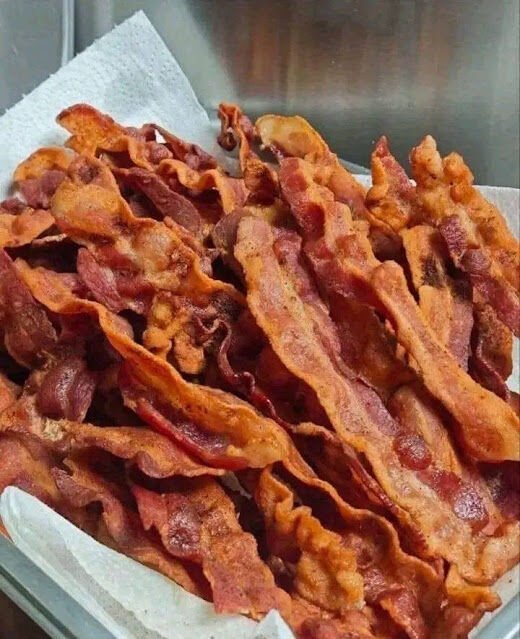If you live for the crackle and crunch of a perfectly cooked bacon strip—but dread the smoke, splatter, and unpredictable burning—this method will change the way you cook bacon forever. Whether you’re making breakfast for two or feeding a crowd, this one simple trick using water ensures even cooking, rich flavor, and crispy results every single time.
Yes, you read that right. Water is the magic ingredient.
And once you try this technique, you’ll never go back to frying bacon the old way.
Why Adding Water to Your Pan Works
Bacon has a high fat content, and traditional cooking methods often cause that fat to render too quickly—leading to burnt edges, rubbery centers, and a smoky kitchen.
The water method changes everything.
- Slows the cooking process: Water tempers the heat at the beginning, allowing the fat to render slowly and evenly without burning the meat.
- Reduces grease splatter: As the water simmers and evaporates, the fat release is controlled, preventing hot oil from popping all over your stovetop.
- Prevents curling and shrinking: The gentle simmer keeps strips flat and uniform, instead of shriveling into unrecognizable bacon worms.
- Makes cleanup easier: Less splatter = less mess.
This method works beautifully whether you’re cooking on the stovetop or in the oven.
Stovetop Recipe: Water-Crisped Bacon
Ingredients:
- Bacon strips (thick-cut recommended)
- Water (about ¼ inch per pan)
Tools:
- Large skillet (preferably nonstick or cast iron)
- Tongs
- Paper towels
- Plate for draining
Instructions:
- Start Cold
Place your bacon strips in a cold skillet in a single layer. Don’t overlap them—they need room to lie flat and cook evenly. - Add Water
Pour in just enough water to cover the bottom of the skillet. Roughly ¼ inch is ideal—enough to create a shallow bath but not drown the bacon. - Simmer Slowly
Turn the heat to medium. As the water heats up, it will start to simmer. This gentle temperature allows the bacon fat to slowly melt away while preventing scorching. - Let the Water Evaporate
Continue cooking as the water simmers off completely. This will take around 8–10 minutes, depending on how much water you used. - Finish Crisping
Once the water is gone, reduce the heat slightly. The bacon will begin to fry in its own rendered fat. Cook until it reaches your desired crispiness, flipping once if needed. - Drain and Serve
Transfer the bacon to a plate lined with paper towels to soak up excess grease. Let it sit for 1–2 minutes before serving—it will continue to crisp slightly as it cools.
Oven-Baked Method (Bonus Style with Less Mess)
Ingredients:
- Bacon strips
- 1–2 tablespoons water
Tools:
- Rimmed baking sheet
- Wire rack (optional but recommended)
- Foil or parchment paper (for easy cleanup)
Instructions:
- Preheat Your Oven
Set your oven to 400°F (200°C). - Set the Stage
Line a rimmed baking sheet with foil or parchment paper for easy cleanup. Place a wire rack on top and lay your bacon strips on the rack in a single layer. - Add Water
Add 1–2 tablespoons of water to the bottom of the baking sheet—not directly on the bacon. This helps prevent burning in the early stages and keeps things moist. - Bake
Roast for 15–20 minutes, depending on thickness. Flip the bacon halfway through for even browning. Keep an eye on it in the final minutes—bacon goes from perfect to burnt quickly. - Drain and Serve
Transfer to paper towels, just like with the stovetop method.
Expert Tips for Bacon Greatness
- Choose Thick-Cut Bacon: Thicker slices hold up better during cooking and render more evenly.
- Use a Wire Rack for Oven Baking: This keeps bacon elevated so it crisps without sitting in its own fat.
- Don’t Rush the Simmer: Letting the water do its work creates the perfect base for crisping later.
- Save the Bacon Grease: Pour the cooled fat into a jar—it’s ideal for frying eggs, roasting potatoes, or adding flavor to greens and cornbread.
- Flavor It Up: Try seasoning your bacon before cooking. A sprinkle of brown sugar, cracked pepper, or smoked paprika adds a delicious twist.
Why This Method Works for Everyone
- Low mess: No grease splatter all over your counters and stove.
- Consistent results: No more half-burnt, half-raw bacon.
- Healthier: More fat is rendered and drained off.
- Versatile: Works for breakfast, burgers, sandwiches, and salads.
Once you try bacon with this water-start method, you’ll understand why it’s become the go-to trick for chefs and home cooks alike. It’s the smallest change with the biggest impact—giving you the perfectly crisp, golden bacon you’ve always wanted.



